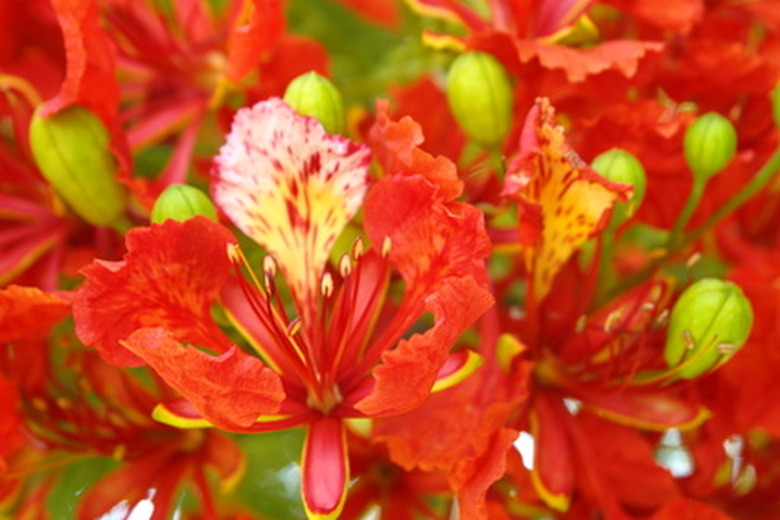Trees That Produce Orange Flowers And Large Green Pods
Tropical trees that produce pods reveal insight into their likely membership in the pea or legume family, Fabaceae. Without pods, chances are they belong to a different plant family. Fewer tropical legume trees display orange flowers, narrowing down the possible plant identification even more. Color can be subjective, especially when you talk of the shades of scarlet and orange-red. Immature seed pods are likely green, but eventually dry to turn a tan or brown color.
Colville's Glory
Few people have ever heard of or seen Colville's glory (Colvillea racemosa), but the interesting flower display and season makes it easy to identify. Native to Madagascar, this feathery foliaged tree with golden tan bark flowers in autumn. On the tips of branches occur many downward clusters of deep orange flowers; collectively the clusters look like bananas or long pine cones from a distance. Large, flat seed pods follow and eventually ripen to a golden brown and split open to reveal horizontally arranged seeds.
- Tropical trees that produce pods reveal insight into their likely membership in the pea or legume family, Fabaceae.
- Fewer tropical legume trees display orange flowers, narrowing down the possible plant identification even more.
Royal Poinciana
Arguably the worlds most magnificent flowering tree, the royal poinciana (Delonix regia) is fittingly also called the flamboyant. In the early tropical summer when the rainy season begins, the broad canopy of this feathery foliaged tree erupts with thousands of five-petaled flowers. Some call the flower color red, while other trees may produce more orange-red blossoms. The enormous seed pods are first green, and then turn brown and linger on the branches upwards of a year. This tree also is native to Madagascar.
Pride-of-Barbados
The floral emblem of the island nation of Barbados, the pride-of-Barbados (Caesalpinia pulcherrima) is also called the dwarf poinciana. Usually a small tree, no taller than 15 to 20 feet, its flowers combine red, orange and yellow tones, making it look orange from a distance. Up close, the flowers are scarlet with petals edged in yellow and long red whisker-like stamens. There is great variability among these trees, as some may flower fully golden orange, others a deep orange-red. The seed pods begin green and turn dark brown. This Caribbean tree blooms across the warm months, and you can seen various developmental stages of buds, flowers and green and brown seed pods on its thorny branches.
- Arguably the worlds most magnificent flowering tree, the royal poinciana (Delonix regia) is fittingly also called the flamboyant.
- There is great variability among these trees, as some may flower fully golden orange, others a deep orange-red.
Rattle Box
Another possibility is that the tree is the rattle box (Sesbania tripetii, synonym Sesbania punicea), also called the scarlet wisteria tree. Fast-growing and looking like a large shrub if lowest branches remain, it has become a noxious weed in subtropical regions like Florida. Native to southern Brazil, Uruguay and Paraguay, clusters of red, orange-red or orange-salmon colored blossoms grace branch tips across summer. Following the flowers are long green seed pods that dry brown and rattle the seeds inside in the casual breeze.
References
- "Tropical and Subtropical Trees"; Margaret Barwick; 2004
- "Flowering Trees of Florida"; Mark K. Stebbins; 1999
